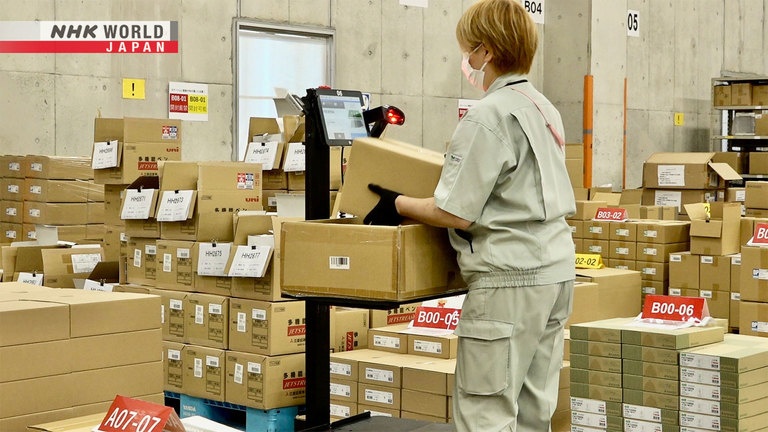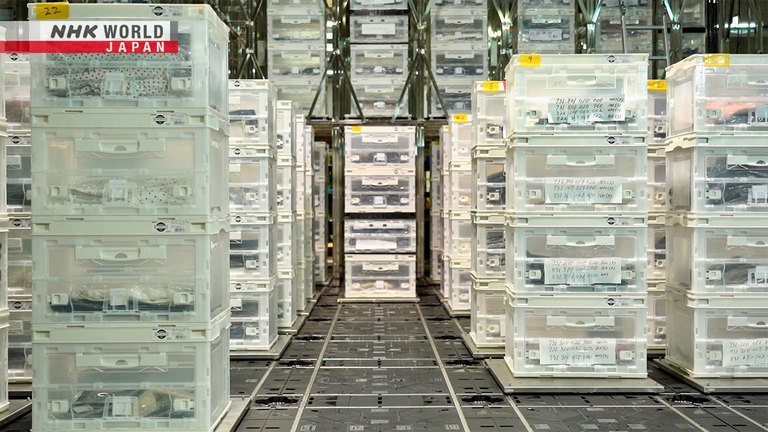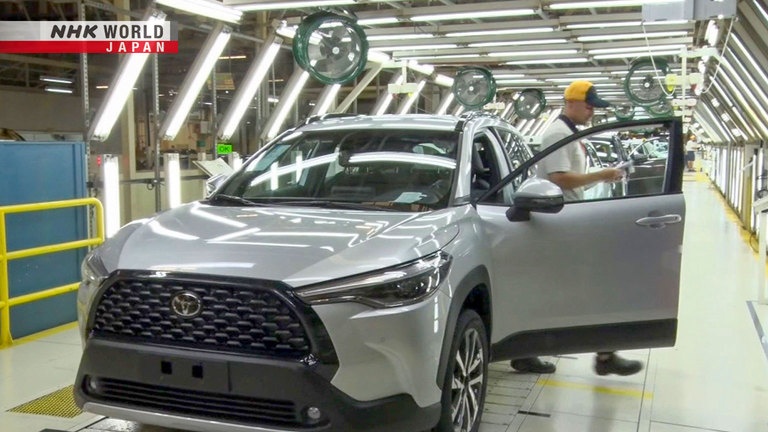Increasing Efficiency in Logistics
Technology isn't just changing how we shop, it's changing how goods are stored and delivered. This episode shows how understaffed distribution warehouses can now call upon robots to assist in retrieving orders and features a new type of automated warehouse that has eliminated the need for aisles between shelves in order to maximize storage capacity.
*Subtitles and transcripts are available for video segments when viewed on our website.
Increasing Efficiency in Logistics

This robot uses AI to navigate busy warehouses and eliminates the need for staff to transport orders all the way from the shelves to the packing and staging areas.

Featuring easy-to-install flooring that contains a proprietary linear motor system, this automated warehouse requires less floor space than a standard warehouse and its moving shelving system can perform both storage and sorting tasks.
Global Trends

In Brazil, bioethanol made from sugarcane is drawing attention due to high gasoline prices. Over three-quarters of new vehicles sold in the domestic market use both types of fuel.

Automakers are eager to develop vehicles that run on bioethanol. Toyota is incorporating bioethanol into its hybrid technology, and Nissan is developing a fuel cell car that uses it.
Transcript
"Protect the Seibu Ikebukuro store!"
Workers at the Sogo & Seibu department store chain took to the streets amid Tokyo's late summer heat
to express their fears about losing their jobs.
Sogo & Seibu has posted losses for the past four fiscal years.
Its parent company, Seven & i Holdings, has now sold it to the US-based fund, Fortress Investment Group.
- Not open today?
- Sorry. The store is closed today.
Honestly, it's very surprising to see a strike actually happening before my eyes.
I think it's very important that employees took action to express their views.
Labor strikes are extremely rare in Japan.
The fact that workers thought it necessary reflects just how severe the challenges facing the industry are.
Department stores used to be a symbol of Japan's prosperity.
But many now struggle in the face of competition from online retailers and specialty shops.
Quite a few have closed as their operators change their business models.
The sale of Sogo & Seibu to a US fund has people in smaller communities worrying about what will happen to their local stores.
Here in Fukui Prefecture on the Sea of Japan coast, Seibu is the only department store.
This is the main place in Fukui.
It's not like the big city. There's no other place to buy high-end products.
I think so many people have benefited.
The store is also the centerpiece for surrounding businesses.
There have been mutual benefits for both Seibu and the community.
I hope it continues to keep the town vibrant.
But an industry analyst says the situation for department stores is quite difficult.
When department stores were the leaders in the retail industry, the customer base was mostly families.
But not anymore. Now, wealthy people and visitors from abroad are the two main customer groups.
But the numbers from these groups are not enough,
meaning stores have to scramble for their share in a market that is much smaller than before.
As a result, department stores are groping for ways to survive.
Some will succeed, but some will not.
And it's not just a story about one industry, but about Japan's economy as a whole.
This is a gas station in Sao Paulo.
In mid-August, the average price of ethanol was about 3.9 reals a liter, or 2 dollars and 50 cents a gallon.
That was about 40 percent cheaper than gasoline.
I think ethanol is a good alternative.
It's easy on the environment, and your wallet.
Customers have been fueling up more with ethanol because of the price.
They see if it's paying off or not, and go with it.
Brazil's bioethanol is made mainly from sugarcane.
Large-scale sugarcane production has been developed in the central-west and southeast of the country.
The government has been promoting bioethanol since the 1970s to reduce its dependence on fossil fuels.
The country has developed so-called "flex-fuel" vehicles that use both gasoline and ethanol.
Such vehicles currently make up about 77% of new car sales in the country.
Bioethanol does emit carbon dioxide when burned.
But CO2 is absorbed by sugarcane, which produces oxygen through photosynthesis.
The CO2 output is offset by the amount absorbed.
So, no additional greenhouse gases are emitted into the atmosphere.
However, bioethanol produces less energy than gasoline and powers vehicles for shorter distances.
Yet, auto experts say biofuel has many benefits.
Brazil can go with ethanol regardless of a fossil fuel shortage or a geopolitical crisis.
We have a huge advantage in environmental conservation, economic stability and energy security.
Automakers have been competing fiercely to develop high-performance flex-fuel vehicles.
In 2019, a Toyota Motor plant on the outskirts of Sao Paulo began producing hybrid flex-fuel vehicles with batteries and electric motors.
Sales of such vehicles have been taking off.
In 2024, the company plans to invest about 350 million dollars to produce affordable compact hybrid-flex vehicles for export to 22 countries.
Our number-one goal is to reduce carbon emissions.
There are electric vehicles, fuel cells and hydrogen engines.
But flex engines that use biofuels are a powerful solution to create an environmentally friendly automobile.
Meanwhile, Nissan Motor is developing fuel cell vehicles that use ethanol to generate electricity to power motors.
The automakers believe it would be difficult to sell electric vehicles in Brazil that require charging stations.
Because Brazil is so large, it will be a challenge to build the infrastructure to charge EVs.
We believe we can install ethanol fuel batteries in all Brazilian EVs.
With gasoline prices getting so high, the focus on Brazil's bioethanol industry is set to intensify.
An automated warehouse that not only brings the needed products right to the front and also saves valuable space.
And, warehouse roaming robots that handle most of the leg-work for their human counterparts.
Today's On-Site Report shows how new developments in robotics and automation are making logistics operations more efficient than ever!
Storing more than 800 different types of office supply products,
this warehouse ships over 8,000 items per day.
Workers here used to spend about half of their time locating and collecting merchandise.
This exhausting work required having to walk over 10km per day while pushing heavy carts back and forth.
That burden was greatly reduced with the introduction of this robot.
It automatically heads to the location in the warehouse where some of the ordered items are stored.
Next, an employee will come to find the proper merchandise.
Confirming the order on the attached display panel, she finds the items and loads them onto the robot.
The employee is then directed to proceed on to where a different robot is already waiting for her to fill the next order.
With storage capacity still available, this robot also heads off to another location in the warehouse for loading.
The best part is, the robot is already there waiting for me, so I don't have to push a heavy cart around.
The robot was designed by Gajan Mohanarajah, who first came to Japan 2001 to study robotics at the Tokyo Institute of Technology.
Our main goal in developing the robot was to reduce the walking distance employees had to cover as much as possible.
The robot does all of the leg work, while the employees handle the selecting tasks.
By implementing a collaborative robot system we can attain a more balanced and efficient work place.
Just how efficient?
For demonstration purposes, we had the same tasks done by a single employee with and without robots and here are the results:
When working alone, the employee had to cover a lot of ground, all while pushing around heavy hand-carts.
When teamed with the robots, however,
the employee was directed to each location via the shortest route possible without having to push any carts.
This resulted in the work being completed in less than half the time with far less walking required.
The system's greatest strength lies in its unique AI technology that simultaneously controls the movements of multiple robots.
When several orders come in, the system calculates the most efficient route between them and sends out multiple robots ahead of the employee.
When unforeseen circumstances occur,
such as employees not being able to arrive as scheduled or aisles becoming too crowded,
the robots automatically exchange information to re-calculate a more viable route.
The resourceful AI system ensures that all orders are processed as smoothly and efficiently as possible.
This year, the warehouse introduced 7 robots into service.
Their addition has helped boost employee productivity by over 50%.
Because the system didn't require any major changes or adaptations to our warehouse,
we were able to make a quick and seamless transition.
Since being made available in 2020, more than 250 logistics companies have implemented Gajan's robots into their facilities.
The majority of our clients are primarily focused on improving efficiency in their existing warehouses,
so we are trying to make the user interface as simple as possible.
We want to create a system where if they can use a smartphone, they can just as easily operate our robots.
This multi-tiered warehouse is packed nearly to the ceiling and lacks a common and usually necessary feature - aisles.
But with a simple press of a button...
Entire racks full of goods begin shifting back and forth and from side to side.
They make way, so the rack containing the requested merchandise can emerge.
In a matter of seconds, the rack appears in front of the employee,
so all they have to do is select the ordered items and be on their way.
This unconventional moving warehouse was developed by Ookubo Katsuhiro,
who previously designed sales management systems for the apparel industry.
At the mercy of seasonal changes and fast-changing fashion trends,
apparel-related logistics must constantly deal with a high level of inventory turnover.
Okubo believed that this could best be dealt with by implementing automated warehouses in the center of large urban areas.
In order to make the most out of the space we had available -
we not only wanted to use all of the warehouse's vertical space but also the dedicated areas where the aisles would normally be.
The next part was the hardest - we tried out sorts of different ideas while trying to figure out how to access the merchandise -
but that's what true innovation is, figuring out how to solve or work around what seems to be the impossible!
The answer came in the form of these floor tiles.
At just over 2 centimeters thick, they are both simple and sturdy and contain the base components of a linear motor system.
The other key piece to the puzzle are these wheeled trays.
When an electric current flows through electromagnets that are built into the floor tiles,
it interacts with magnet arrays attached to the bottom of the trays,
propelling them forward, backward, or side to side.
By combing this unique tile-based linear motor system with an AI program,
a large number of trays can be controlled simultaneously -
allowing for the desired tray to come to the front for easy access.
Installation is simple - the tiles just need to be laid out and properly on a solid, flat surface and connected to a power supply.
If the tiles are supported by a sturdy, well-balanced frame,
they can take advantage of a large amount of vertical storage space.
This flexibility allows them to be organized and expanded to fit almost any location.
In the spring of 2022, Okubo's company conducted a trial at a baggage storage area in Tokyo Station.
The experiment showed that the system could be used in areas with extremely limited amounts of space.
With further testing and modifications complete, the system is now set to be used by over 10 companies across Japan -
the majority of them being apparel related.
Our automated warehouse system lets clients turn locations that were previously unusable into viable distribution centers -
allowing them to get their merchandise as close to the consumer as possible.
With more urban-based warehouses, we can change the way products are stored and delivered in metropolitan areas.